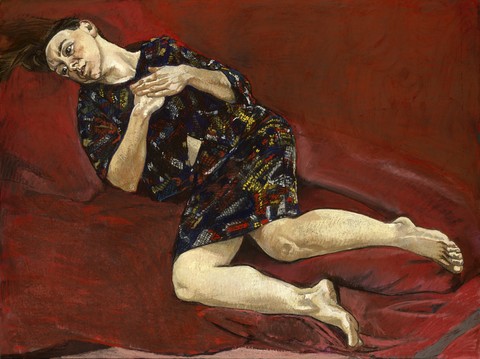
Paula Rego
Power relations, sexuality, and mythology are common threads running through the work of Paula Rego (b. 1935). Her...
Kunstmuseum Den Haag has a treasure chamber of over 160.000 pieces of art. Here we work on making the highlights from this collection available online.
Kunstmuseum Den Haag has purchased The Pillowman (2004), one of the highlights of the oeuvre of Paula Rego (b. 1935, Lisbon). Rego painted The Pillowman after seeing Martin McDonagh’s play of the same name at the National Theatre in London. It is regarded as a Rego masterpiece in pastels, the medium she has been using to outstanding effect in her work since the 1990s. Rego proves in this work not only that she is able to precisely capture the complex scenes – full of references and layers of information – but also that she is a masterful colourist. All her accomplishments in terms of content and technique come together in The Pillowman, her pièce de résistance. The museum has been able to purchase this work thanks to financial support from the Rembrandt Association, the Mondrian Fund, the VriendenLoterij lottery, the Friends of Kunstmuseum Den Haag and the Mondrian Business Club.
Paula Rego situates The Pillowman in the Portugal of her childhood: at the beach, with the small town of Estoril in the background. Like Martin McDonagh, she is an undisputed master of role reversal. She recycles ‘his’ young girl who wants to be Jesus as her main character in the left panel. Another girl on the right panel, intent on murdering her stepfather, has stuck razor blades into apples. These women will not let themselves be oppressed by God, or by any commandment. AS Rego reconstructed the long, pillowlike figure of the title she realised that he symbolised her father in her work: a consoling figure who, given his recurrent depression, is depicted in the left panel slumped lethargically in a chair. As in other mature work by Rego, she manages here to make the universal personal, and vice versa.
“Oh The Pillowman, The Pillowman! The Pillowman is perhaps Paula’s greatest work. She certainly thinks it’s one of her most important works, if not the most accomplished work. Why? Because it’s the one that is technically the most beautifully drawn with pastel. She was at the height of her powers when she made that picture. But it’s also because it incorporates the very essence of what she was doing at that period. Which is starting with a story that she likes, but doesn’t know why she likes it. A play by Martin McDonagh: The Pillowman. But as she starts to draw she realizes that the reason she wants to do it is because it’s actually about something in her childhood that is unresolved, that she hasn’t come to terms with yet. So that’s the itch that needs scratching. It’s really a picture about her that is inspired about a story outside her.” – Nick Willing, son of the artist
Enriching the collection
The Pillowman by Paula Rego is a perfect addition to Kunstmuseum Den Haag’s collection. It fits seamlessly into a long line of modern artists who use their own visual idiom to depict the complexity of human emotional life – a line that extends from Odilon Redon, via expressionism, to artists like Francis Bacon, Berlinde De Bruyckere and Nalini Malani. This psychological perspective allows us increasingly to connect the art of the early twentieth century with the art of today.
The work of both Louise Bourgeois – several examples of which are in the museum’s collection – and Paula Rego has a psychological basis. Rego takes a Jungian perspective, while Bourgeois’s is more Freudian, yet both artists draw on their own personal recollections of childhood. The hanging doll in Bourgeois’s Cell XXVI also bears a visual similarity to ‘Pillowman’. Furthermore, Rego’s The Pillowman is a fabulous addition alongside work by other artists (some of them also British) in our collection who have sought to express the human condition in all its reality. They include Bacon, Lucian Freud and R.B. Kitaj, who along with Rego featured in the much-discussed ‘All Too Human’ exhibition at the Tate Gallery in 2018.
Kunstmuseum Den Haag’s collection also includes several triptychs which, each in its own way, connects with this one by Rego. Piet Mondrian’s Evolution (1911), for example, like The Pillowman, is drenched in symbolism, and Untitled (1971) by Paul Thek was also inspired by the ideas of Carl Jung.
About Paula Rego
Paula Rego (b. 1935, Lisbon) is the grande dame of contemporary art in Britain and Portugal. Elsewhere, she is known mainly to aficionados, though this is now changing rapidly. The major retrospective shown at Tate in 2021, now at Kunstmuseum Den Haag to 20 March, will then move to its final venue, the Picasso Museum in Málaga, Spain. Preparations are also underway for several more impressive international exhibitions of her art. The work of Paula Rego will for example feature strongly at the forthcoming Venice Biennale.
In the 1970s, on the advice of her Jungian therapist, Paula Rego actively explored fairytales, folk tales and myths, and came across the illustrations by Gustave Doré, Walt Disney and, some time later, Honoré Daumier. This marked a breakthrough in her work. In her psychological realism she often uses well-known literary works as a basis for her paintings. She makes these stories her own by, for example, situating them in places in Portugal associated with her childhood, thus creating her very own idiom. Rego seeks in her work to change the past, and to correct past wrongs, focusing particularly on her own family, Portuguese society and the art world. There is a museum dedicated to her work in Cascais, Portugal.
“I always need a story. Without a story, I can’t get going. Maybe the story changes in the doing of it. I might discover it isn’t what I thought or intended. But I need it to find my way. I’m always looking for new stories.” – Paula Rego